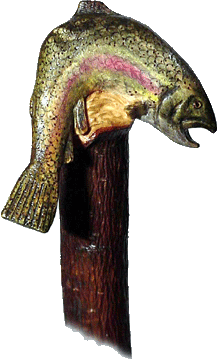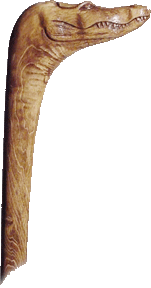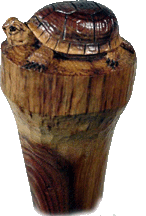#1408 Rainbow Trout VIII
Carved in apple wood, 2000
 WHAT DOES ONE DO
WHAT DOES ONE DO
WITH A WALKING STICK?
Many of the pieces are designed and intended as works
of art. The owners display them in a variety of ways. Some
stand in containers such as umbrella stands, antique barrels,
or custom made display racks. A very simple method, the one the artist has
used in his home, is to suspend them from a nail or decorative
picture frame hanger with monofilament fishing line. The line
is not visible from a distance and the piece appears to hang
on the wall just as a painting might.
Regarding sticks that are intended to be used, The artist categorized these into four different classes; the hiking stick, the walking stick, the dress cane, and the support cane.
The hiking stick is a staff that serves the serious hiker as a tool. It should be about shoulder height, stout enough to lend good support, and hard enough to take a beating without losing its attractiveness.
|
The walking stick has no such restrictions. The person carrying it decides what it is. It may be a fragile work of art intended strictly for show; it may a stout weapon-like piece carried for personal protection like the Irish shillelagh; it may be leaned upon or not. The length of the walking stick is equally ill-defined. I think of a walking stick as being about waist to breast-high and designed to be gripped below the top. T he classic gentleman's dress cane is a fashionable piece to carry but not intended for support. Such a piece is generally slender and arty with the traditional length being from the floor to the break of the wrist. |
Finally, the support cane is intended as something to be leaned upon and, as such, has its height very specifically defined by its user. The cane must be long enough to allow the owner to lean on it.comfortably with a slight crook at both the elbow and wrist. If this is a genuine orthopedic device the length is critical. As little as a quarter inch difference in the length of a cane can
 cause
discomfort or perhaps produce a bad effect in a hip or back.
The cane must have a comfortable handle and obviously must be
stout enough to lend reliable support. The cane intended for
this purpose should be fitted by an orthopedic professional.
cause
discomfort or perhaps produce a bad effect in a hip or back.
The cane must have a comfortable handle and obviously must be
stout enough to lend reliable support. The cane intended for
this purpose should be fitted by an orthopedic professional.
Each piece has a logo and number burned into the lower shaft and
comes with a card that bears the title, identifies the wood, and includes
some descriptive legend. When a design is repeated, the number of times is
indicated by a Roman numeral following the name. The artist has kept a record of each piece that includes
a sketch, when it was carved, the source of the wood, what sort
of finish was applied, and any other items of interest concerning
the carving. The record also includes the name and location of
the owner of each piece. On several occasions people returned
years later to report that a piece had changed hands and requested
that a note of that be made in the record books.
